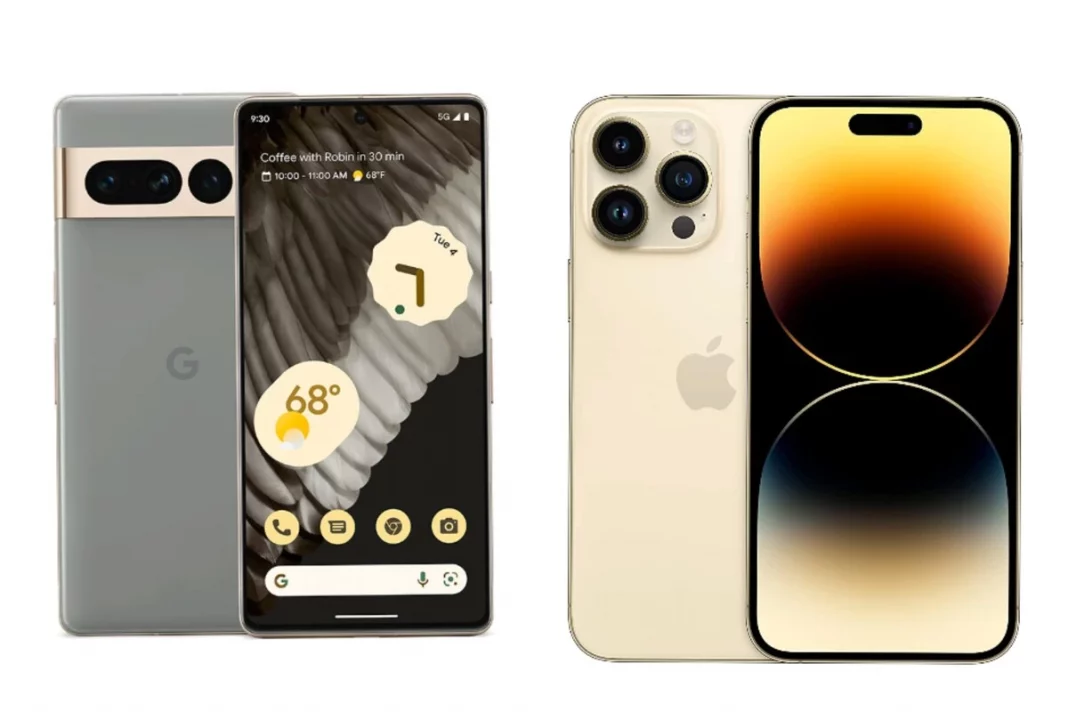Google Pixel 7 Pro vs iPhone 14 Pro Max: The Google Pixel series has long been the favourite of Android enthusiasts and smartphone photography gurus, but due to subpar technology and a lack of global availability, they have always been niche devices, never approaching the economic success or general awareness of the iPhone.
Google, on the other hand, has taken steps to reverse that in recent years, beginning with the superb Pixel 6 series, which brought new premium hardware highlighted by Google’s first-ever custom-built silicon. The Pixel 7 series maintains that pace, with the Pro model finally giving the complete combo of premium hardware, enhanced software, and top performance.
Google Pixel 7 Pro vs iPhone 14 Pro Max: Specifications
| Specifications | Apple iPhone 14 Pro Max | Google Pixel 7 Pro |
|---|---|---|
| Build | Stainless steel mid-frame”Ceramic Shield” front and back | Aluminum mid-frameGorilla Glass Victus backGorilla Glass Victus front |
| Dimensions & Weight | 6.3 x 3.05 x 0.31 inches (160.7 x 77.6 x 7.9mm)8.47 ounces (240g) | 6.41 x 3.02 x 0.35 inches (162.9 x 76.6 x 8.9mm)7.48 ounces (212g) |
| Display | 6.7-inch Super Retina XDR OLEDProMotion refresh rate between 1Hz and 120Hz | 6.7-inch QHD+ 120Hz AMOLEDVariable refresh rate between 10Hz to 120Hz |
| SoC | Apple A16 Bionic | Google Tensor G2 |
| RAM & Storage | 6GB RAM128GB/256GB/512GB/1TB | 12GB RAM128GB/256GB/512GB |
| Battery & Charging | 4,323mAh20W wired fast charging7.5W wireless charging15W MagSafe wireless chargingNo charger in box | 5,000mAh30W wired fast charging23W wired fast chargingNo charger in box |
| Security | Face ID | Optical in-display fingerprint scanner |
| Rear Camera(s) | Primary: 48MP wide, f/1.8 apertureSecondary: 12MP ultra-wide, f/1.8 apertureTertiary: 12MP telephoto, 3x optical zoom, f/2.8Quarternary: LIDAR camera | Primary: 50MP wide, Samsung GN1, f/1.9, 1/1.31-inchSecondary: 12MP ultra-wide, f/2.2Tertiary: 48MP Periscope, f/3.5 |
| Front Camera(s) | 12MP | 11MP |
| Port(s) | Lightning | USB-C |
| Audio | Stereo speakers | Stereo speakers |
| Connectivity | 5G (sub-6 GHz and mmWave)Gigabit LTE with 4×4 MIMO and LAAWi-Fi 6 (802.11ax) with 2×2 MIMOBluetooth 5.0 | 5G (mmWave) for almost all regions and carriers except AT&T in the USWi-Fi 6 (802.11ax) with 2×2 MIMOBluetooth 5.2NFC |
| Software | iOS 16 | Android 13 |
| Other features | Dual eSIM in U.S., Dual physical SIM elsewhere | Dual physical SIM in some regionsFace Unlock |
Display
Both have a 6.7-inch screen and can sustain a dynamic refresh rate of up to 120Hz.
The iPhone completely embraces this with a new Always-On display (basically, a slightly dimmed standard lock screen) that runs at just 1Hz, but the Pixel can only drop to 10Hz at the most and uses a simpler, all-black background for the Always-on function.
The big new iPhone display feature, though, has to be Apple’s new pill cutout, dubbed the Dynamic Island. It bubbles and extends like a live status bar for your iPhone’s current active events. What a brilliant idea! The Pixel, on the other hand, employs a standard punch hole design.
Battery
Apple has historically used lower battery sizes in its iPhones, and the iPhone 14 Pro Max is no exception. It has a 4,323mAh battery as opposed to the Pixel 7 Pro’s 5,000mAh battery.
Performance and Software
Google says it began working on its first Tensor chip nearly three years before the Pixel 6, and the Pixel 7 Pro features a more polished, second-generation version of the CPU. Tensor G2 improves across the board, with a focus on machine learning (ML).
Apple’s A16 Bionic chip, on the other hand, improves CPU performance slightly, has quicker graphics memory bandwidth, and is more power efficient.
Keep watching our YouTube Channel ‘DNP INDIA’. Also, please subscribe and follow us on FACEBOOK, INSTAGRAM, and TWITTER.


